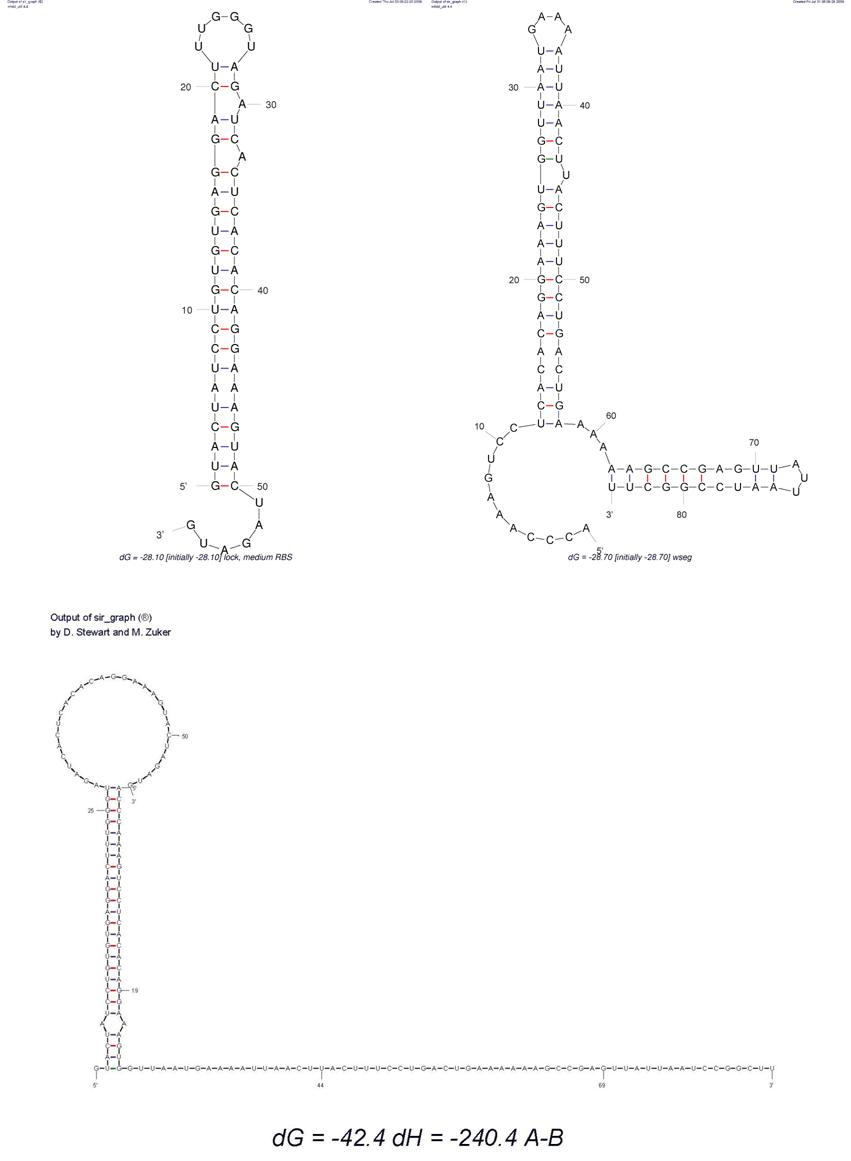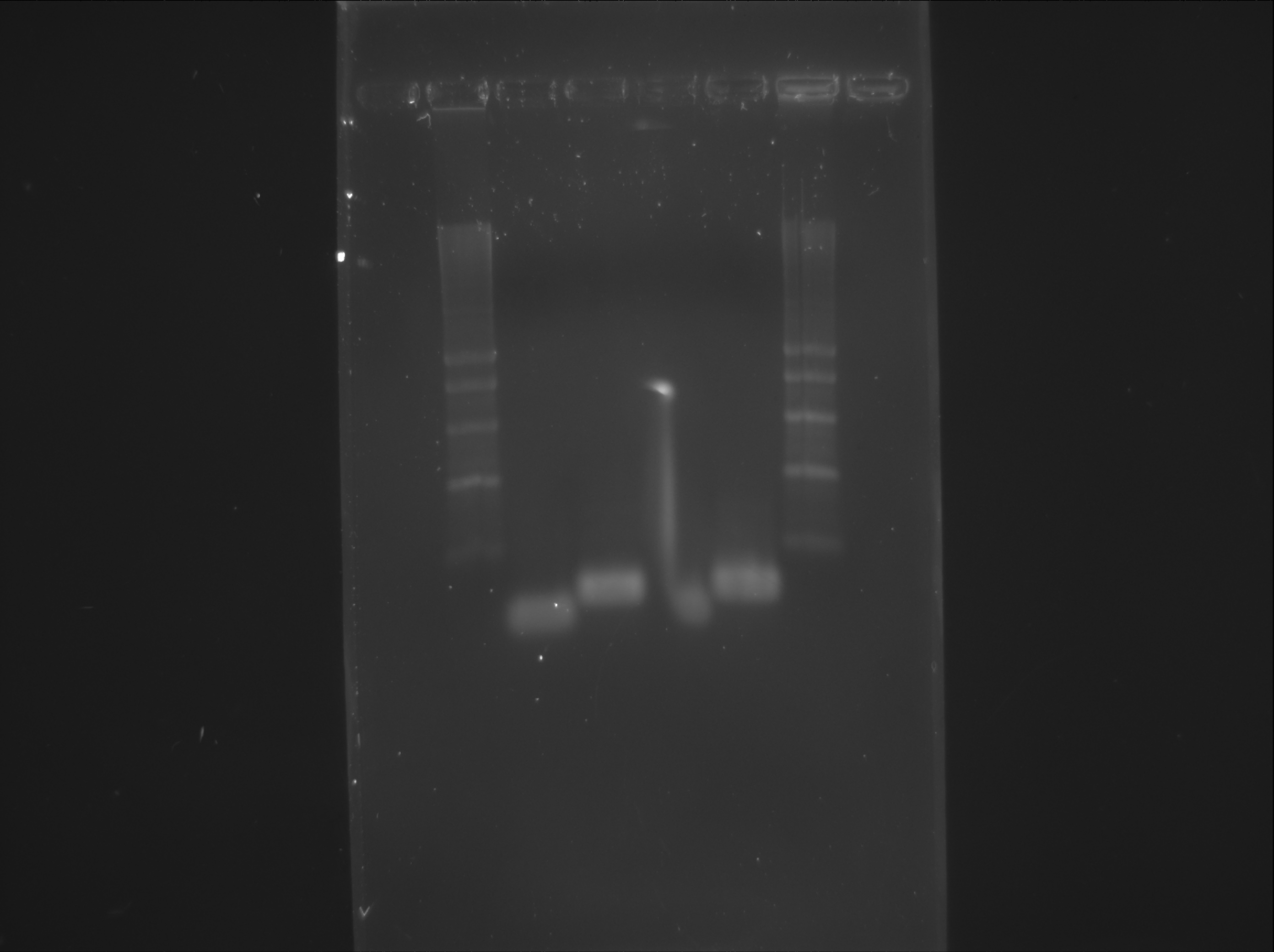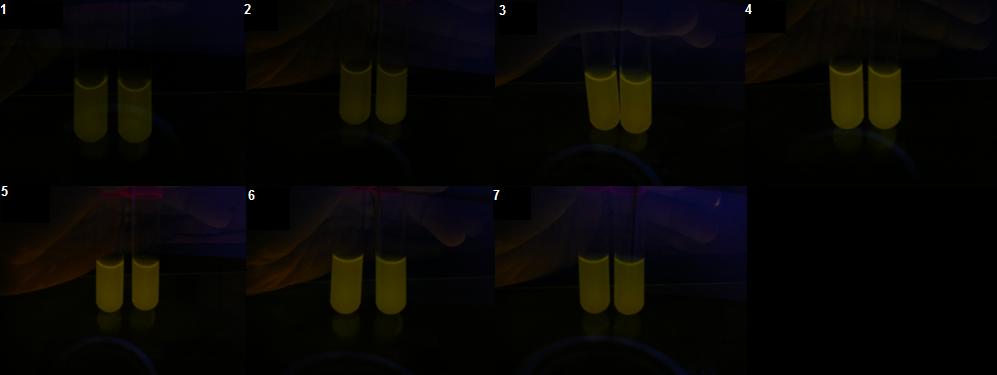Team:TUDelft/Results3
Results
Main results
- Construction of an algorithm capable to generate locks (cis regulation) for different ribosome binding sites (RBS’s) and their correspond key (trans).
- Online lock and key generator derived from the algorithm.
- Construction of four DNA sequences in biobrick format and [http://partsregistry.org/wiki/index.php?title=Part:BBa_pSB1A3 pSB1A3] plasmid backbone which encode lock for medium RBS ([http://partsregistry.org/wiki/index.php?title=Part:BBa_K175031 K175031]), key for the lock of medium RBS ([http://partsregistry.org/wiki/index.php?title=Part:BBa_K175032 K175032]), lock for weak RBS ([http://partsregistry.org/wiki/index.php?title=Part:BBa_K175029 K175029]) or key for the lock of weak RBS ([http://partsregistry.org/wiki/index.php?title=Part:BBa_K175030 K175030]).
- Assembly of two composed biobricks ([http://partsregistry.org/wiki/index.php?title=Part:BBa_K175034 K175034] and [http://partsregistry.org/wiki/index.php?title=Part:BBa_K175035 K175035]), designed to test the functionality of the lock/key pairs constructed.
- Assembly of two GFP generators under the control of PLacI with weak RBS ([http://partsregistry.org/wiki/index.php?title=Part:BBa_K175033 K175033]) or medium RBS ([http://partsregistry.org/wiki/index.php?title=Part:BBa_K175048 K175048]).
Results
Following the steps of the algorithm described in the plan, an online lock and key generator was developed. Using the generator, two lock/key pairs were designed: [http://partsregistry.org/wiki/index.php?title=Part:BBa_K175031 K175031], [http://partsregistry.org/wiki/index.php?title=Part:BBa_K175032 K175032], [http://partsregistry.org/wiki/index.php?title=Part:BBa_K175029 K175029] and [http://partsregistry.org/wiki/index.php?title=Part:BBa_K175030 K175030] which use the medium and weak RBS in the registry. The predicted secondary structures of the RNA produced by the locks and keys were analyzed using Mfold. Figure D shows the secondary structure of the lock, key and the interaction of both for the weak RBS. It is possible to notice that the lock blocks the RBS, this avoids the translation of the coding part downstream the RBS. When the key is present, the most favored secondary structure is the one where the RBS is free allowing translation. The same explanation can be applied to the lock and the key for medium RBS, see figure E.
The coding DNA for the locks and keys designed before were synthesized as described in the protocols section. Figure F shows the bands for the locks and keys obtained. They were assembled with [http://partsregistry.org/wiki/index.php?title=Part:BBa_pSB1A3 pSB1A3] backbone.
2µL of the assembly mix for each lock and key were used to transform electro-competent Escherichia coli TOP10 cells. 250 µL of cells suspension were used to inoculate four plates with proper antibiotic as selection marker. The plates were incubated at 37ºC overnight. A colony obtained from each plate was used to inoculate 5 mL LB tubes. The tubes were incubated overnight at 37ºC an 175 rpm. The resulted cultures were used to obtain miniprep DNA plasmids which were used for the following assemblies (see below) and to send the parts to the registry.
In order to test the functionality of the new boibricks, two parts were designed: for weak RBS [http://partsregistry.org/wiki/index.php?title=Part:BBa_K175034 K175034] and [http://partsregistry.org/wiki/index.php?title=Part:BBa_K175035 K175035] for medium RBS (see the design). The assembly of these parts was successful. Besides, two GFP generators with inducible promoter PLacI ([http://partsregistry.org/wiki/index.php?title=Part:BBa_R0010 R0010]) and weak or medium RBS were assembled, [http://partsregistry.org/wiki/index.php?title=Part:BBa_K175033 K175033] and [http://partsregistry.org/wiki/index.php?title=Part:BBa_K175048 K175048] respectively. The [http://partsregistry.org/wiki/index.php?title=Part:BBa_K175034 K175034], [http://partsregistry.org/wiki/index.php?title=Part:BBa_K175035 K175035] and [http://partsregistry.org/wiki/index.php?title=Part:BBa_K175033 K175033] sequences were confirmed.
2µL of the assembly mix for each part described above were used to transform electro-competent E. coli TOP10 cells. 250 µL of cells suspension were used to inoculate four plates with proper antibiotic as selection marker. The plates were incubated at 37ºC overnight. A colony obtained from each plate was used to inoculate 5 mL LB tubes. The tubes were incubated overnight at 37ºC an 175 rpm. The resulted cultures were used to obtain miniprep DNA.
The resulted plates for the GFP generators were glowing green even though the presence of PLacI. This indicated a lack of LacI or an excessive production of the plasmid (since a high copy number plasmid was used). A literature review showed that TOP10 cells do not have LacI. Thus, we continue the lab work using k12 E. coli which it is known to produce LacI. Contrary to our expectations, plates with the GFP generators were glowing again, this could be explain in at least two ways: 1) there is a big leakage in the control of PLacI and/or 2) the high copy derived from a high copy number plasmid therefore the LacI present in the cells is not enough to block the action of PLacI.
In order to identify the problem, two strategies were designed. In order to elucidate a shortage of LacI a simple kinetic and a kinetic in a 96-well reader (see below) were done. The simple kinetic consisted in inoculation of 250 μL of cells transformed with one of the plasmids constructed to test the new biobricks in a 4mL minimal medium tube which was incubated overnight at 37°C and 175 rpm. 2mL of the resulted cultures were used to inoculate 2mL minimal medium tubes from which fluorescence was followed for 9 h using a normal black lamp and an orange filter.
The expected results were an increasing in the intensity or glowing in the tubes induced with 2mM IPTG compared with the control. This should probe that even with the leakage and the permanent green glow, the induction accelerates the process of GFP production. Unfortunately, this could not be appreciated in the simple kinetics (see figures G and H). These results showed that the leakage is not the cause of the expression of GFP.
Although, this does not characterize the biobricks, it shows that the RBS is exposed and GFP is expressed. In a positive scenario, this might indicate that the lack of repressor allows the expression of the keys, which interaction with the lock release the RBS and hence allows the expression of the protein downstream the RBS
On the other hand, the construction of a LacI generator [http://partsregistry.org/wiki/index.php?title=Part:BBa_K175028 K175028] with constitutive promoter was designed in order to assembled together with the biobricks and test them. However, due to the lack of time the attempts to construct this part were unsuccessful. It remains as the most promising solution that should be tested further.
 "
"












